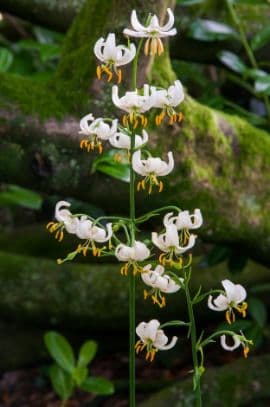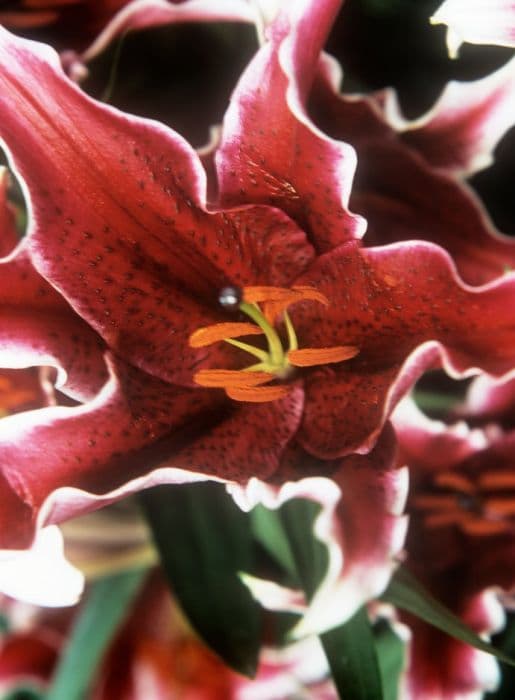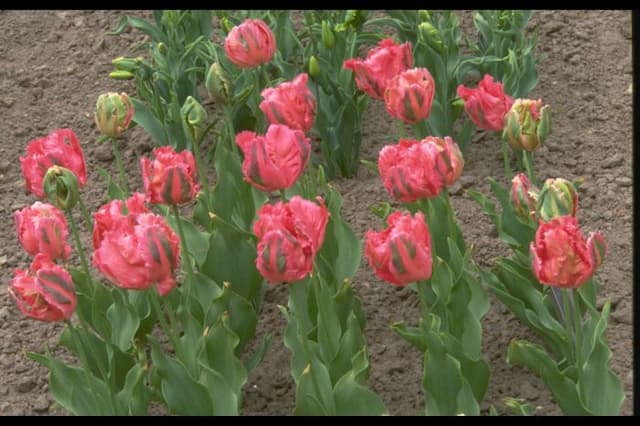Pagoda Dogtooth Violet Erythronium 'Kondo'

ABOUT
Erythronium 'Kondo', commonly known as the 'Pagoda' dog's-tooth violet, is a charming perennial valued for its aesthetic appeal. The plant features long, slender leaves that are glossy in texture and announce themselves with a vibrant green color that may display attractive brownish mottling. These leaves spiral around the base, creating an attractive ground-hugging rosette. Come spring, 'Kondo' graces the garden with its especially beautiful flowers. Each flower has six recurved petals that create a distinctive, delicate, lily-like form. The petals themselves are a stunning shade of creamy yellow, adding a soft yet bright touch of color to any planting. The blooms gracefully nod atop slender stems, each arching away from the foliage in a poised display. The charm of the 'Pagoda' dog's-tooth violet extends to its stamens and pistil, which are prominently displayed and provide a lovely contrast to the petals in both color and texture, often showing up as a richer hue in the center that seduces the viewer's gaze. In addition to its visually pleasurable qualities, 'Kondo' harmonizes elegantly with other spring flowers and is often planted in drifts for a naturalistic woodland effect. It appears particularly at home among ferns and other shade-loving plants. Its overall aspect is delicate and undoubtedly attractive, contributing a touch of refinement and sophisticated beauty to any garden space that can offer it the cool, shaded environment it prefers.
About this plant
 Names
NamesFamily
Liliaceae
Synonyms
Pagoda Dogtooth Violet, Dog's Tooth Violet, Trout Lily
Common names
Erythronium 'Kondo'
 Toxicity
ToxicityTo humans
Erythronium 'Kondo', commonly known as the dog's tooth violet or trout lily, is not typically considered toxic to humans. No significant toxicity or symptoms of poisoning are generally associated with ingestion of this plant. Accidental consumption should not result in harm, but it is always recommended to avoid ingesting plants that are not specifically grown for food.
To pets
The dog's tooth violet or trout lily, known scientifically as Erythronium 'Kondo', has no known significant toxic effects on pets. It is not commonly listed as a poisonous plant for pets such as cats and dogs. Therefore, if a pet were to ingest part of this plant, they likely would not suffer from any serious consequences or symptoms of poisoning. However, it is always wise to prevent pets from eating plants not intended for their consumption to avoid any potential digestive upset.
 Characteristics
CharacteristicsLife cycle
Perennials
Foliage type
Deciduous
Color of leaves
Green
Flower color
Yellow
Height
1 foot (0.3 meters)
Spread
1 foot (0.3 meters)
Plant type
Bulb
Hardiness zones
3
Native area
Japan
Benefits
 General Benefits
General Benefits- Aesthetic Appeal: Erythronium 'Kondo', commonly known as the dogtooth violet, offers delicate beauty to gardens with its distinctive nodding flowers and mottled foliage.
- Spring Interest: It blooms in early spring, providing one of the first splashes of color after the winter months.
- Naturalizing: Dogtooth violets spread over time, creating natural drifts in woodland gardens or shaded areas.
- Attracts Pollinators: The flowers attract bees and other pollinators, which are essential for the health of the garden ecosystem.
- Low Maintenance: Once established, Erythronium 'Kondo' is relatively low maintenance, requiring minimal care beyond a suitable planting location.
- Drought Tolerant: Though it prefers moist conditions, it can tolerate periods of dryness once fully established.
- Deer and Rodent Resistance: The plant is not typically favored by deer or rodents, reducing the risk of damage in areas with wildlife.
- Shade Tolerance: Dogtooth violets are well-suited for shaded garden areas where other plants might struggle to grow.
 Medical Properties
Medical PropertiesThis plant is not used for medical purposes.
 Air-purifying Qualities
Air-purifying QualitiesThis plant is not specifically known for air purifying qualities.
 Other Uses
Other Uses- Erythronium 'Kondo', commonly known as dogtooth violet, can be used as a natural dye for fabrics, with different parts of the plant producing varying shades.
- The leaves of the dogtooth violet can be used in a compost heap, as they decompose well and add nutrient value to the compost mix.
- Dogtooth violet's dried petals could potentially be added to potpourri mixtures due to their interesting color and shape, contributing to the visual appeal of the mix.
- The plant can act as a visual cue in gardens to indicate soil health and pH, as Erythronium 'Kondo' tend to thrive in specific soil conditions.
- Dogtooth violet can be used in educational settings for botanical studies, demonstrating bulb development and perennial growth patterns.
- The bulbs of this plant may serve as a food source for foraging wildlife, such as squirrels or birds, in an ecosystem-friendly garden.
- Photographers and visual artists may find inspiration in the unique beauty of Erythronium 'Kondo' for their art projects or nature photography.
- Garden design enthusiasts can use dogtooth violet to create a ‘spring ephemeral’ theme in their garden, taking advantage of its short-lived bloom season.
- Enthusiasts of phenology – the study of cyclic and seasonal natural phenomena – can observe and track the flowering patterns of Erythronium 'Kondo' over time.
- In the culinary arts, while not commonly consumed, the blossoms have the potential to be crystallized and used as decorative edible elements on desserts.
Interesting Facts
 Feng Shui
Feng ShuiThe plant Erythronium is not used in Feng Shui practice.
 Zodiac Sign Compitability
Zodiac Sign CompitabilityThe plant Erythronium is not used in astrology practice.
 Plant Symbolism
Plant Symbolism- Beauty: Erythronium 'Kondo', commonly known as Pagoda Dogtooth Violet, has delicate, attractive flowers that symbolize natural beauty.
- Resilience: As a spring ephemeral, the plant emerges quickly in the spring and can thrive in cold climates, representing the ability to overcome adversity.
- Rarity: This plant is not as commonly found as others, which can symbolize uniqueness or preciousness.
- Renewal: Blooming in early spring, it signifies the end of winter and the beginning of a new cycle of growth and renewal.
- Hope: The emergence of the plant after the long winter months can be a sign of hope and the promise of forthcoming abundance.
 Water
WaterThe Dogtooth Violet should be watered moderately during its growth period, ensuring the soil is damp but not waterlogged. Typically, watering once a week with about 1 gallon of water per plant is adequate, depending on soil type and climate conditions. Decrease watering after the foliage begins to die back post-flowering, as this plant prefers drier conditions during dormancy. Ensure good drainage to avoid root rot, and during prolonged dry spells, additional watering may be necessary to keep the soil mildly moist.
 Light
LightDogtooth Violets thrive best in dappled sunlight or partial shade, mirroring their natural woodland habitat. Ideally, place them where they can receive morning sun and afternoon shade, or filtered light throughout the day. Direct afternoon sunlight should be avoided to prevent scorching of the leaves.
 Temperature
TemperatureDogtooth Violets prefer a temperate environment with temperatures ranging between 35 to 75 degrees Fahrenheit. They can survive minimum temperatures down to about 20 degrees Fahrenheit but will die back in the winter. The ideal growing temperature for these plants is within the 50 to 70 degrees Fahrenheit range during their active growth in spring.
 Pruning
PruningPruning Dogtooth Violet is not commonly required as the plant naturally dies back after flowering. However, after the foliage has yellowed and died down, it can be trimmed away to keep the area tidy. This is typically done once a year, in late autumn or early winter when the plant has become dormant.
 Cleaning
CleaningAs needed
 Soil
SoilPagoda Dogtooth Violet prefers rich, well-drained soil with high organic matter. The best mix includes equal parts of loam, leaf mold or compost, and sharp sand for drainage. The soil pH should be slightly acidic to neutral, between 6.0 and 7.0.
 Repotting
RepottingPagoda Dogtooth Violet rarely needs repotting as it prefers to be undisturbed. Repot the plant only if it becomes overcrowded, about every 3-5 years, in the late summer after the leaves have died back.
 Humidity & Misting
Humidity & MistingPagoda Dogtooth Violet thrives in moderate to high humidity levels, ideally between 50% and 70%, which resemble its natural woodland habitat.
 Suitable locations
Suitable locationsIndoor
Use well-drained soil, bright indirect light, high humidity.
Outdoor
Plant in dappled shade, moist, well-draining rich soil.
Hardiness zone
3-9 USDA
 Life cycle
Life cycleErythronium 'Kondo', commonly known as Pagoda Dogtooth Violet, begins as a bulb underground, which remains dormant during the summer. In the early spring, the bulb sends up a stem with a pair of glossy, mottled leaves and a flower stalk with dainty, drooping yellow flowers. The plant actively grows during the cooler spring months and after flowering, the seeds are produced and dispersed for propagation, usually by ants attracted to their elaiosomes. As the spring season ends and summer heat begins, Erythronium 'Kondo' enters a period of dormancy, with the foliage dying back and the bulb storing energy for the next growth cycle. In autumn, the bulb may increase in size or produce offsets, hence gradually expanding its presence in the garden. The cycle repeats itself each spring, with the bulb re-sprouting to resume growth, flower, and set seed.
 Propogation
PropogationPropogation time
Spring
The most popular method of propagation for Erythronium 'Kondo', commonly known as the dogtooth violet, is through division of the bulbs. The best time to propagate these plants is in late summer, after the foliage has died back and the plant is dormant. Carefully dig up the clump of bulbs, making sure to keep as many roots intact as possible. Gently separate the bulbs by hand, ensuring that each offset or division has some roots attached. Replant these divisions immediately at the same depth they were growing before, spacing them about 6 to 8 inches (15 to 20 centimeters) apart to allow for adequate space to grow. Water the newly planted bulbs well to help them establish in their new location.



![Lily [Roselily Chelsea]](/_next/image?url=https%3A%2F%2Fplants-admin.emdemapps.com%2Fimages%2Fplants%2F%2Fimages%2F604b584f6f830.png&w=640&q=75)





